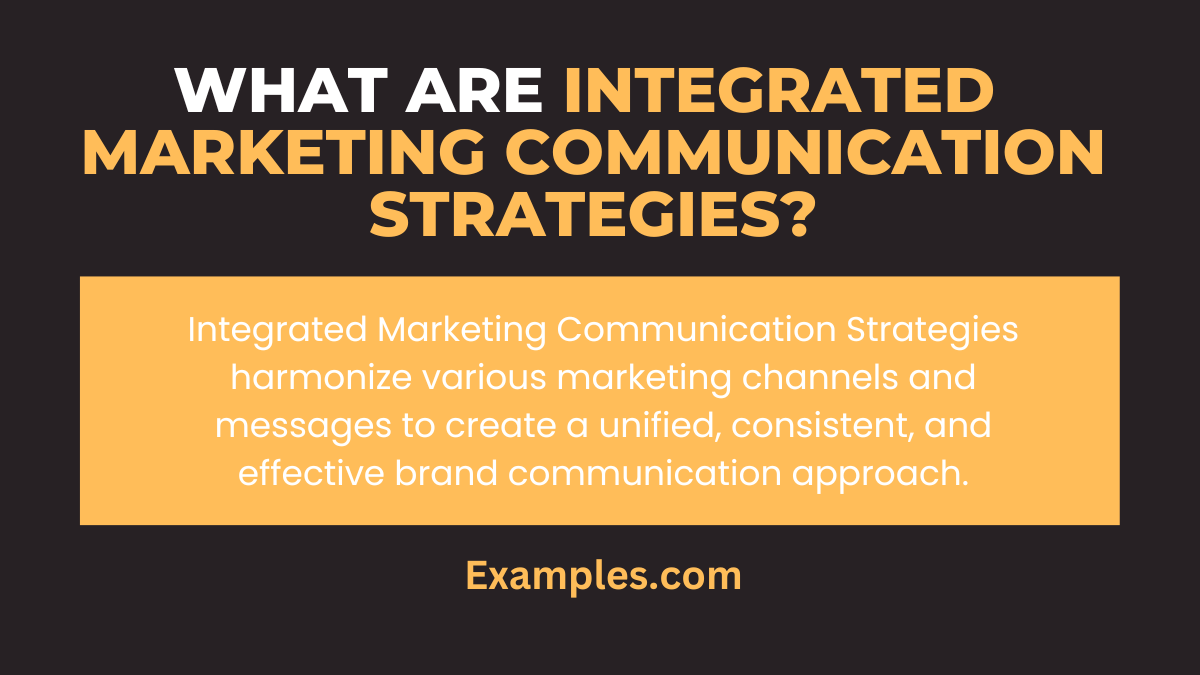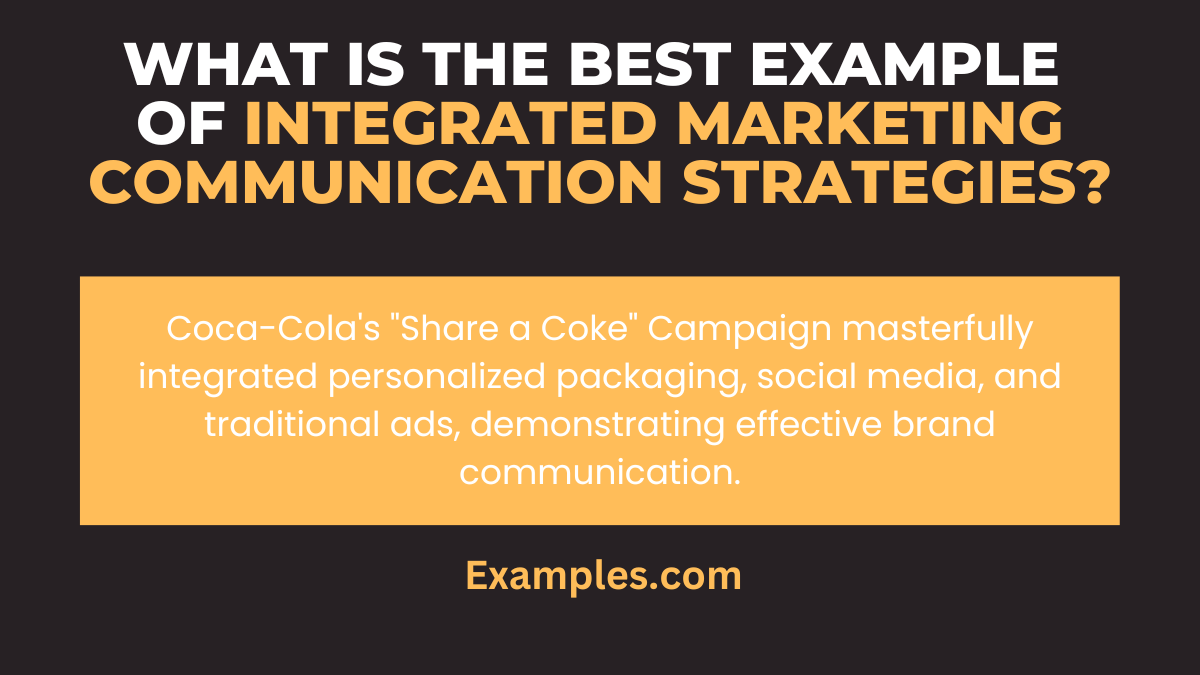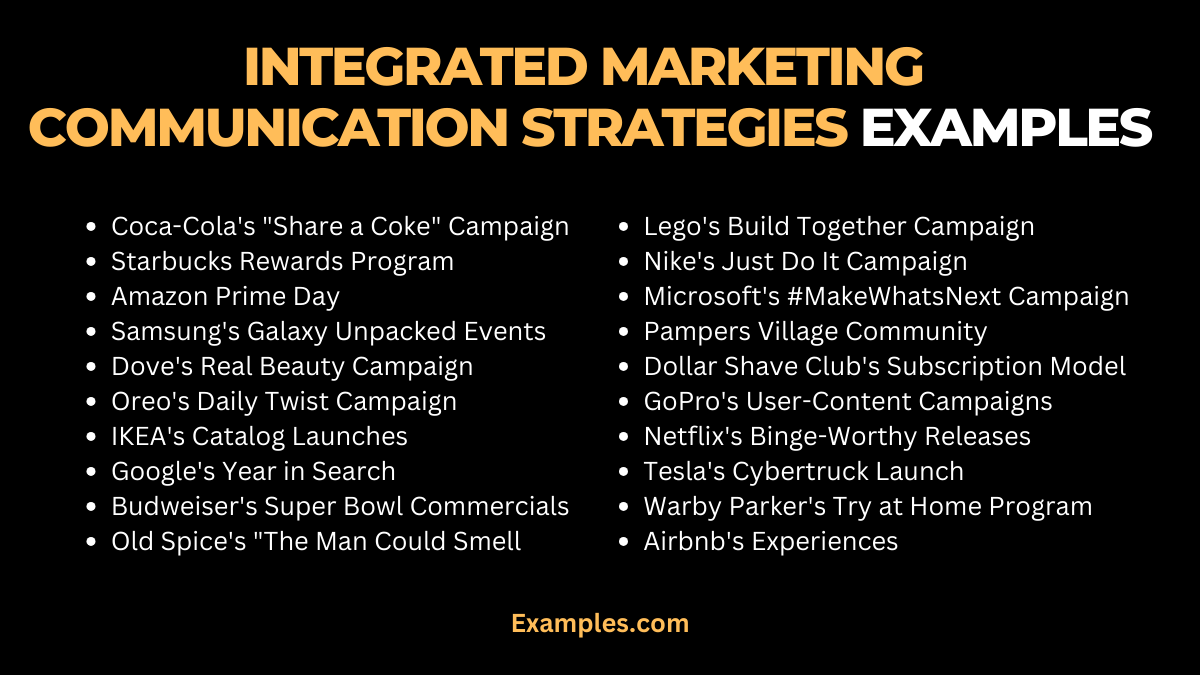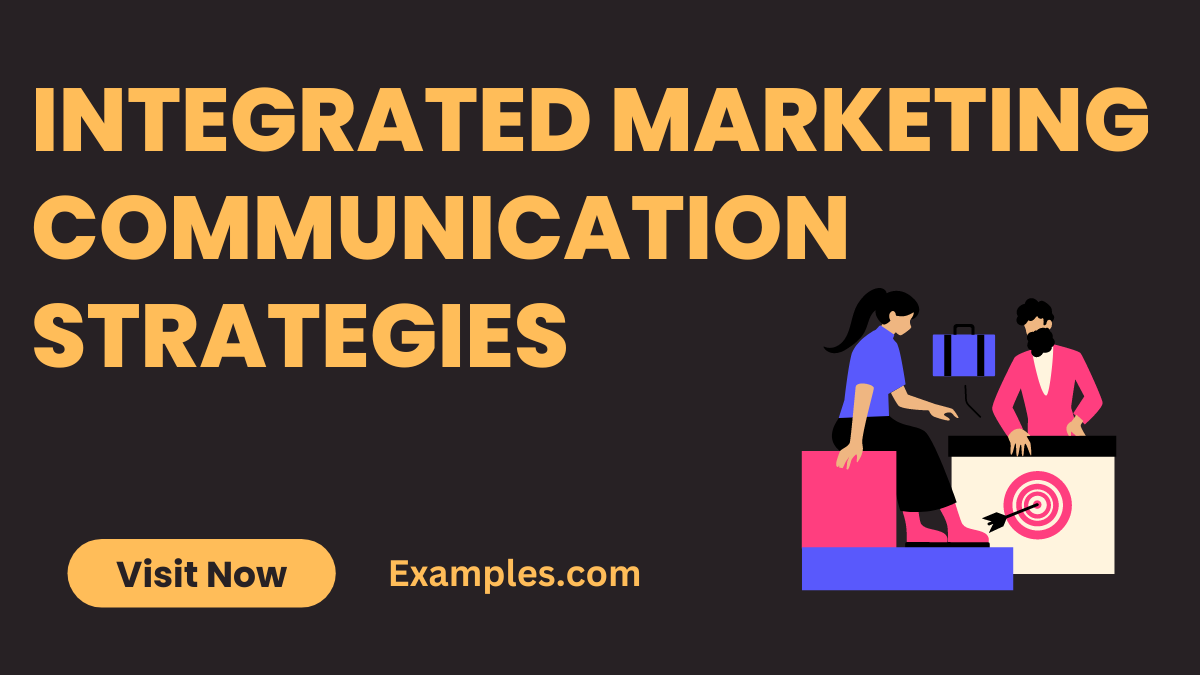19+ Integrated Marketing Communication Strategies Examples
Embark on a comprehensive journey through the world of Integrated Marketing Communication Strategies. Discover effective techniques, insightful tips, and real-world examples that showcase the power of seamless communication across marketing channels. This guide is a valuable resource for businesses seeking to enhance their brand presence and engagement through integrated and harmonized marketing efforts.
What are Integrated Marketing Communication Strategies?

Integrated Marketing Communication Strategies involve harmonizing promotional efforts across various channels to convey a consistent brand message. In simple terms, it’s the art of unifying communication to create a seamless and impactful brand narrative.
What is the Best Example of Integrated Marketing Communication Strategies?

Explore a pinnacle case: Coca-Cola’s “Share a Coke” Campaign. This strategy seamlessly integrated personalized packaging, social media engagement, and traditional advertising. By combining online and offline elements, Coca-Cola created a unified and memorable campaign, showcasing the effectiveness of integrated marketing in fostering widespread brand communication and engagement.
20 Integrated Marketing Communication Strategies Examples

Unlock the potential of Integrated Marketing Communication with these 20 impactful examples. Seamlessly blending channels for a cohesive brand narrative, these strategies showcase the power of integrated approaches.
- Coca-Cola’s “Share a Coke” Campaign: Personalized packaging, social media, and traditional advertising harmonized to create a unified brand experience.
- Starbucks Rewards Program: Integrated mobile app, email campaigns, and in-store promotions create a cohesive customer loyalty strategy.
- Amazon Prime Day: Amazon integrates online promotions, exclusive deals, and social media buzz for a unified shopping event.
- Samsung’s Galaxy Unpacked Events: Combining live events, online streaming, and social media, Samsung ensures a cohesive product launch experience.
- Dove’s Real Beauty Campaign: Dove integrates TV ads, social media, and online content to promote its inclusive beauty message.
- Oreo’s Daily Twist Campaign: Leveraging social media, events, and online engagement, Oreo created a cohesive daily storytelling experience.
- Old Spice’s “The Man Your Man Could Smell Like” Campaign: TV ads, social media, and interactive websites integrated to create a memorable brand character.
- IKEA’s Catalog Launches: Integrated campaigns combine print catalogs, online content, and social media to unveil new collections.
- Google’s Year in Search: Google integrates online trends, video content, and social media to showcase the year’s highlights.
- Budweiser’s Super Bowl Commercials: Budweiser harmonizes TV ads, online teasers, and social media engagement for Super Bowl campaigns.
- Lego’s Build Together Campaign: Social media challenges, in-store events, and online content integrated for a cohesive community-building strategy.
- Nike’s Just Do It Campaign: Nike unifies its iconic slogan across TV ads, social media, and athlete endorsements for a consistent brand message.
- Microsoft’s #MakeWhatsNext Campaign: Integrated social media, events, and online content to inspire and empower women in STEM.
- Pampers Village Community: Pampers integrates online forums, content, and social media to create a supportive parenting community.
- Dollar Shave Club’s Subscription Model: Integrated online subscriptions, social media engagement, and targeted email campaigns for a seamless user experience.
- GoPro’s User-Generated Content Campaigns: GoPro integrates user-generated content across social media, online platforms, and events for authentic storytelling.
- Netflix’s Binge-Worthy Releases: Integrated teasers, social media engagement, and targeted emails create a cohesive strategy for new releases.
- Tesla’s Cybertruck Launch: Elon Musk integrates live events, online streaming, and social media for a groundbreaking product launch.
- Warby Parker’s Try at Home Program: Online orders, in-home trials, and social media engagement integrate for a seamless eyewear shopping experience.
- Airbnb’s Experiences: Integrating online listings, reviews, and social media, Airbnb creates a cohesive platform for unique travel experiences.
Integrated Marketing Communication Strategies Examples For Sponsorship
Unlock the potential of Integrated Marketing Communication Strategies in sponsorship with these impactful examples. From tailored collaborations to harmonized messaging, explore how brands seamlessly integrate their sponsorships into comprehensive marketing strategies.
- Red Bull Stratos Jump: Red Bull seamlessly integrated its sponsorship of Felix Baumgartner’s stratospheric jump, creating a cohesive narrative across TV, online streaming, and social media platforms.
- Nike and the Olympics: Nike’s sponsorship of Olympic athletes transcends traditional advertising, employing integrated strategies across digital and traditional channels to create a unified and impactful message.
- Pepsi and Super Bowl Halftime Shows: Pepsi leverages its Super Bowl halftime show sponsorship by integrating online engagement, social media campaigns, and celebrity endorsements to ensure a consistent and captivating viewer experience.
- Adobe’s Sponsorship of Creative Events: Adobe strategically integrates its sponsorship of creative events by combining online webinars, social media engagement, and product placements to communicate its commitment to the creative community.
- Toyota’s Sports Event Sponsorships: Toyota seamlessly integrates its sponsorship of sports events by combining TV advertising, social media engagement, and experiential marketing, creating a unified and impactful brand presence.
Integrated Marketing Communication Strategies Examples in Business
Explore how businesses effectively deploy Integrated Marketing Communication Strategies to amplify their brand presence and engage audiences cohesively across various channels.
- Apple’s Product Launch Events: Apple harmonizes its product launches with integrated communication, combining live events, online streaming, social media teasers, and retail displays for a unified and captivating brand introduction.
- IBM’s Thought Leadership Webinars: IBM showcases integrated communication in business through thought leadership webinars, combining online seminars, social media discussions, and follow-up email campaigns for a cohesive educational experience.
- Microsoft’s Software Launches: Microsoft employs integrated strategies for software launches, combining live demonstrations, online tutorials, social media teasers, and targeted email campaigns to ensure a seamless and comprehensive communication approach.
- HubSpot’s Inbound Marketing Campaigns: HubSpot excels in integrated communication for inbound marketing, combining blog content, social media promotion, email newsletters, and webinars to create a cohesive and engaging user journey.
- Salesforce’s Annual Conferences: Salesforce integrates its annual conferences by combining keynote presentations, online streaming, social media engagement, and interactive booths to communicate its latest innovations and industry insights cohesively.
How can Businesses Effectively Implement Integrated Marketing Communication Strategies to Enhance their Brand Presence?
Businesses can optimize their brand presence by strategically deploying Integrated Marketing Communication Strategies, fostering a cohesive approach across channels. This comprehensive guide outlines the steps to seamlessly integrate various communication channels and enhance overall brand visibility.
- Audience Segmentation: Begin by identifying and segmenting your target audience to tailor communication strategies that resonate with specific demographics.
- Consistent Messaging: Establish a unified brand message that seamlessly transitions across all communication channels, ensuring consistency and clarity.
- Channel Integration: Integrate various channels such as social media, traditional advertising, and online platforms to create a holistic brand presence.
- Data Analysis: Utilize data analytics to gain insights into audience behavior, preferences, and interactions, enabling more informed and targeted communication.
- Cross-Functional Collaboration: Foster collaboration between marketing, sales, and customer service teams to ensure a synchronized and cohesive approach to communication.
- Feedback Mechanisms: Implement feedback mechanisms to continuously assess the effectiveness of communication strategies and make real-time adjustments for optimal results.
What Role do Integrated Marketing Communication Strategies Play in Creating a Cohesive and Impactful Brand Narrative?
Integrated Marketing Communication Strategies play a pivotal role in weaving together a seamless and impactful brand narrative. This guide explores the key elements involved in crafting a compelling narrative that resonates with audiences across various channels.
- Storytelling Approach: Develop a storytelling approach that aligns with brand values, allowing audiences to connect emotionally with the narrative.
- Brand Consistency: Ensure consistency in brand elements, including visuals, tone, and messaging, across all communication touchpoints for a cohesive narrative.
- Unified Customer Experience: Integrate communication efforts to provide customers with a unified and consistent experience, irrespective of the channel they engage with.
- Emphasis on Values: Communicate brand values effectively, fostering a deeper connection with the audience and reinforcing the narrative.
- Adaptability to Trends: Stay attuned to market trends and audience preferences, allowing the narrative to evolve and remain relevant over time.
- Interactive Content: Incorporate interactive and engaging content formats, such as videos, polls, and quizzes, to enhance audience participation in the brand narrative.
What Objectives and Styles are Associated with the Implementation of Integrated Marketing Communication Strategies?
Explore the various objectives and communication styles linked to the effective implementation of Integrated Marketing Communication Strategies. This guide outlines the key elements to consider in developing strategies that align with organizational goals and resonate with the target audience.
- Objectives Alignment: Ensure that communication objectives align with broader business goals, whether it’s brand awareness, lead generation, or customer retention.
- Pull and Push Styles: Implement a mix of pull (customer-driven) and push (brand-driven) communication styles to cater to different stages of the customer journey.
- Consistent Brand Image: Maintain a consistent brand image across all communication styles to reinforce brand identity and recognition.
- Behavioral Objectives: Set behavioral objectives to guide customer actions, whether it’s making a purchase, signing up for a newsletter, or engaging on social media.
- Educational Communication: Incorporate educational elements in communication to inform and empower the audience, establishing the brand as an industry authority.
- Emotional Connection: Craft communication styles that evoke emotions, fostering a deeper connection with the audience and influencing their perception of the brand.
In conclusion, this guide illuminates the power of Integrated Marketing Communication Strategies, showcasing their pivotal role in crafting cohesive brand narratives. By exploring diverse examples and offering a comprehensive roadmap, businesses can navigate the dynamic landscape of communication. Embracing these strategies ensures a unified approach, resonating with audiences and elevating brands to new heights of success.



